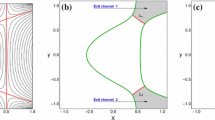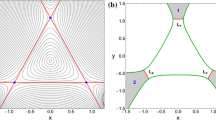Abstract
The escape mechanism of the four hill potential is explored. A thorough numerical investigation takes place in several types of two-dimensional planes and also in a three-dimensional subspace of the entire four-dimensional phase space in order to distinguish between bounded (ordered and chaotic) and escaping orbits. The determination of the location of the basins of escape toward the different escape channels and their correlations with the corresponding escape time of the orbits is undoubtedly an issue of paramount importance. It was found that in all examined cases all initial conditions correspond to escaping orbits, while there is no numerical indication of stable bounded motion, apart from some isolated unstable periodic orbits. Furthermore, we monitor how the fractality evolves when the total orbital energy varies. The larger escape periods have been measured for orbits with initial conditions in the fractal basin boundaries, while the lowest escape rates belong to orbits with initial conditions inside the basins of escape. We hope that our numerical analysis will be useful for a further understanding of the escape dynamics of orbits in open Hamiltonian systems with two degrees of freedom.












Similar content being viewed by others
Notes
A sticky orbit is a special type of orbit which behaves as a regular one for long time intervals before it exhibits its true chaotic nature.
The phenomenon of almost zero fractality, at the basin boundaries, at relatively high energy levels seems to be common in several types of Hamiltonian systems. For example, the same behavior is also observed in the Hénon-Heiles system but only for high enough values of the total orbital energy \((E > 2)\).
The dimension of the complete phase space of a Hamiltonian system with N degrees of freedom is 2N. This phase space is foliated into \(2N-1\)-dimensional invariant leaves corresponding to the numerical values of the Hamiltonian. However, the dimension of the entire phase space always remains 2N, irrelevantly of any possible invariant foliation.
The same phenomenon of the loss of the symmetry of a dynamical system due to the particular choice of the initial conditions of the orbits also applies for other types of Hamiltonian systems. For example, in the Hénon–Heiles system the \(2\pi /3\) symmetry is observable only in the configuration (x, y) space and only by using polar coordinates. On the other hand, for initial conditions of orbits in the \((y,\dot{y})\) phase space the three escape channels are no longer equiprobable (see, e.g., the series of papers on the Hénon-Heiles system by Sanjuán and collaborators).
References
Aguirre, J., Vallego, J.C., Sanjuán, M.A.F.: Wada basins and chaotic invariant sets in the Hénon–Heiles system. Phys. Rev. E 64, 066208-1–066208-11 (2001)
Aguirre, J., Viana, R.L., Sanjuán, M.A.F.: Fractal structures in nonlinear dynamics. Rev. Mod. Phys. 81, 333–386 (2009)
Barrio, R., Blesa, F., Serrano, S.: Fractal structures in the Hénon–Heiles Hamiltonian. Europhys. Lett. 82, 10003 (2008)
Barrio, R., Blesa, F., Serrano, S.: Bifurcations and safe regions in open Hamiltonians. New J. Phys. 11, 053004-1–053004-12 (2009)
Benet, L., Trautman, D., Seligman, T.: Chaotic scattering in the restricted three-body problem. I. The Copenhagen Problem. Celest. Mech. Dyn. Astron. 66, 203–228 (1996)
Benet, L., Seligman, T., Trautman, D.: Chaotic scattering in the restricted three-body problem II. Small mass parameters. Celest. Mech. Dyn. Astron. 71, 167–189 (1998)
Bleher, S., Grebogi, C., Ott, E., Brown, R.: Fractal boundaries for exit in Hamiltonian dynamics. Phys. Rev. A 38, 930–938 (1988)
Bleher, S., Ott, E., Grebogi, C.: Routes to chaotic scattering. Phys. Rev. Lett. 63, 919–922 (1989)
Bleher, S., Grebogi, C., Ott, E.: Bifurcation to chaotic scattering. Phys. D 46, 87–121 (1990)
Churchill, R.C., et al.: In Casati, G., FordsComo, J. (eds.) Conference Proceedings on Stochastic Behavior in Classical and Quantum Hamiltonian Systems. Lecture Notes in Physics, Vol. 93, p 76. Springer, Berlin (1979)
Contopoulos, G.: Asymptotic curves and escapes in Hamiltonian systems. Astron. Astrophys. 231, 41–55 (1990)
Contopoulos, G.: Order and Chaos in Dynamical Astronomy. Springer, Berlin (2002)
Contopoulos, G., Kaufmann, D.: Types of escapes in a simple Hamiltonian system. Astron. Astrophys. 253, 379–388 (1992)
Contopoulos, G., Kandrup, H.E., Kaufmann, D.: Fractal properties of escape from a two-dimensional potential. Phys. D 64, 310–323 (1993)
Contopoulos, G., Harsoula, M., Lukes-Gerakopoulos, G.: Periodic orbits and escapes in dynamical systems. Celest. Mech. Dyn. Astron. 113, 255–278 (2012)
Croustalloudi, M., Kalvouridis, T.: Attracting domains in ring-type N-body formations. Planet. Space Sci. 55, 53–69 (2007)
Daza, A., Wagemakers, A., Georgeot, B., Guéry-Odelin, D., Sanjuán, M.A.F.: Basin entropy: a new tool to analyze uncertainty in dynamical systems. Sci. Rep. 6, 31416 (2016)
de Moura, A.P.S., Letelier, P.S.: Fractal basins in Hénon-Heiles and other polynomial potentials. Phys. Lett. A 256, 362–368 (1999)
de Moura, A.P.S., Grebogi, C.: Countable and uncountable boundaries in chaotic scattering. Phys. Rev. E 66, 046214 (2002)
Drótos, G., Jung, C., Tél, T.: When is high-dimensional scattering chaos essentially two dimensional? Measuring the product structure of singularities. Phys. Rev. E 86, 056210 (2012)
Drótos, G., Montoya, F.G., Jung, C., Tél, T.: Asymptotic observability of low-dimensional powder chaos in a three-degrees-of-freedom scattering system. Phys. Rev. E 90, 022906 (2014)
Drótos, G., Jung, C.: The chaotic saddle of a three degrees of freedom scattering system reconstructed from cross section data. J. Phys. A 49, 235101 (2016)
Ernst, A., Peters, T.: Fractal basins of escape and the formation of spiral arms in a galactic potential with a bar. Mon. Not. R. Astron. Soc. 443, 2579–2589 (2014)
González, F., Drótos, G., Jung, C.: The decay of a normally hyperbolic invariant manifold to dust in a three degrees of freedom scattering system. J. Phys. A 47, 045101 (2014)
Hénon, M.: Numerical exploration of the restricted problem, V. Astron. Astrophys. 1, 223–238 (1969)
Jung, C., Lipp, C., Seligman, T.H.: The inverse scattering problem for chaotic Hamiltonian systems. Ann. Phys. 275, 151–189 (1999)
Jung, C., Mejia-Monasterio, C., Seligman, T.H.: Scattering one step from chaos. Phys. Lett. A 198, 306–314 (1995)
Jung, C., Merlo, O., Seligman, T.H., Zapfe, W.P.K.: The chaotic set and the cross section for chaotic scattering in three degrees of freedom. New J. Phys. 12, 103021 (2010)
Jung, C., Scholz, H.J.: Cantor set structure in the singularities of classical potential scattering. J. Phys. A 20, 3607–3617 (1987)
Jung, C., Tél, T.: Dimension and escape rate of chaotic scattering from classical and semiclassical cross section data. J. Phys. A 24, 2793–2805 (1991)
Kalvouridis, T.J.: On some new aspects of the photo-gravitational Copenhagen problem. Astrophys. Space Sci. 317, 107–117 (2008)
Kalvouridis, T.J., Gousidou-Koutita, MCh.: Basins of attraction in the Copenhagen problem where the primaries are magnetic dipoles. Appl. Math. 3, 541–548 (2012)
Kandrup, H.E., Siopis, C., Contopoulos, G., Dvorak, R.: Diffusion and scaling in escapes from two-degrees-of-freedom Hamiltonian systems. Chaos 9, 381–392 (1999)
Kennedy, J., Yorke, J.A.: Basins of Wada. Phys. D 51, 213–225 (1991)
Kumari, R., Kushvah, B.S.: Stability regions of equilibrium points in restricted four-body problem with oblateness effects. Astrophys. Space Sci. 349, 693–704 (2014)
Lai, Y.-C., Tél, T.: Transient Chaos. Springer, New York (2011)
Lyapunov, A.: Probléme general de las stabilité de mouvement. In: Annals of Mathematical Studies, vol. 17 (1949)
Navarro, J.F., Henrard, J.: Spiral windows for escaping stars. Astron. Astrophys. 369, 1112–1121 (2001)
Ott, E.: Chaos in Dynamical Systems. Cambridge University Press, Cambridge (1993)
Poon, L., Campos, J., Ott, E., Grebogi, C.: Wada basins boundaries in chaotic scattering. Int. J. Bifurc. Chaos 6, 251–266 (1996)
Press, H.P., Teukolsky, S.A., Vetterling, W.T., Flannery, B.P.: Numerical Recipes in FORTRAN 77, 2nd edn. Cambridge University Press, Cambridge (1992)
Schneider, J., Tél, T., Neufeld, Z.: Dynamics of leaking Hamiltonian systems. Phys. Rev. E 66, 066218 (2002)
Schneider, J., Tél, T.: Extracting flow structures from tracer data. Ocean Dyn. 53, 64–72 (2003)
Seoane, J.M., Aguirre, J., Sanjuán, M.A.F., Lai, Y.C.: Basin topology in dissipative chaotic scattering. Chaos 16, 023101-1–023101-8 (2006)
Seoane, J.M., Sanjuán, M.A.F., Lai, Y.C.: Fractal dimension in dissipative chaotic scattering. Phys. Rev. E 76, 016208-1–016208-6 (2007)
Seoane, J., Sanjuán, M.A.F.: Exponential decay and scaling laws in noisy chaotic scattering. Phys. Lett. A 372, 110–116 (2008)
Seoane, J., Sanjuán, M.A.F.: New developments in classical chaotic scattering. Rep. Prog. Phys. 76, 016001 (2013)
Skokos, C.: Alignment indices: a new, simple method for determining the ordered or chaotic nature of orbits. J. Phys. A Math. Gen. 34, 10029–10043 (2001)
Skokos, Ch., Antonopoulos, Ch., Bountis, T.C., Vrahatis, M.N.: Detecting order and chaos in Hamiltonian systems by the SALI method. J. Phys. A Math. Gen. 37, 6269–6284 (2004)
Sweet, D., Ott, E.: Fractal basin boundaries in higher-dimensional chaotic scattering. Phys. Lett. A 266, 134–139 (2000)
Tuval, I., Schneider, J., Piro, O., Tél, T.: Opening up fractal structures of three-dimensional flows via leaking. Europhys. Lett. 65, 633–639 (2004)
Waalkens, H., Burbanks, A., Wiggins, S.: A computational procedure to detect a new type of high-dimensional chaotic saddle and its application to the 3D Hill’s problem. J. Phys. A 37, L257–L265 (2004)
Waalkens, H., Burbanks, A., Wiggins, S.: Escape from planetary neighbourhoods. MNRAS 361, 763–775 (2005)
Wolfram, S.: The Mathematica Book. Wolfram Media, Champaign (2003)
Zotos, E.E.: A Hamiltonian system of three degrees of freedom with eight channels of escape: the great escape. Nonlinear Dyn. 76, 1301–1326 (2014)
Zotos, E.E.: Escapes in Hamiltonian systems with multiple exit channels: part I. Nonlin. Dyn. 78, 1389–1420 (2014)
Zotos, E.E.: Revealing the escape mechanism of three-dimensional orbits in a tidally limited star cluster. MNRAS 446, 770–792 (2015)
Zotos, E.E.: Escapes in Hamiltonian systems with multiple exit channels: part II. Nonlin. Dyn. 82, 357–398 (2015)
Zotos, E.E.: Fractal basin boundaries and escape dynamics in a multiwell potential. Nonlin. Dyn. 85, 1613–1633 (2016)
Zotos, E.E.: Fractal basins of attraction in the planar circular restricted three-body problem with oblateness and radiation pressure. Astrophys. Space Sci. 361, 181 (2016)
Acknowledgements
I would like to gratefully and sincerely thank Dr. Christof Jung for all the illuminating discussions during this research. My warmest thanks also go to the two anonymous referees for the careful reading of the manuscript as well as for all the apt suggestions and comments which allowed us to improve both the quality and the clarity of the paper.
Funding The author states that he has not received any research grants.
Author information
Authors and Affiliations
Corresponding author
Ethics declarations
Conflict of interest
The author declares that he has no conflict of interest.
Rights and permissions
About this article
Cite this article
Zotos, E.E. Elucidating the escape dynamics of the four hill potential. Nonlinear Dyn 89, 135–151 (2017). https://doi.org/10.1007/s11071-017-3441-1
Received:
Accepted:
Published:
Issue Date:
DOI: https://doi.org/10.1007/s11071-017-3441-1




